The number of tourists who chose to visit Veneto in 2009 is slightly down on that of the previous year. The number of arrivals dropped by 1.3%, or 185,000 people, though there were still an impressive 60-million-plus nights spent in Veneto (-0.3%). The flow of tourists had shown a notable increase in growth rates since 2005. This came to a halt in 2008, though less so than in the rest of Italy and in our European competitors, such as Spain and France, where there is a considerable downward trend in the number of visitors.
Thanks to the millions of tourists who choose Veneto for their holidays, it has been the leading tourist region in Italy for quite a few years now. This continued into 2008, the last year for which national data is available, with 14.8% of arrivals and 16.2% of nights spent in the entire country.This survey, however, takes into account only tourists who stay for at least one night, namely visitors staying in accommodation for tourism, business, wellbeing or religion, etc.. The calculations therefore do not take into account day trippers drawn by important events and exhibitions. Although they cannot be quantified, they are highly significant for the economy of the Veneto region. Just one example is provided by the 80,000 spectators who came to the First Edition of "Veneto: Spettacoli di Mistero" in November (Table 12.1.1), (Figure 12.1.1), (Figure 12.1.2) and (Figure 12.1.3).
 Origin and destinations Origin and destinations
Tourism in Veneto is characterised by a high number of international visitors (59.4%), whose nights spent increased by 0.6% against a 1.8% decrease in the total number of arrivals. This indicates that in 2009 fewer international tourists came to Veneto than in 2008, but on average they spent a longer period here (4.3 days). These increases have partly compensated for the decrease in the number of nights spent by Italian visitors (-1.6%), accompanied by a reduction, albeit slight, in the number of arrivals (-0.5%).
In 2009 there was a notable increase in the number of nights spent and visits by German and Austrian tourists, with whom the variety of attractions in Veneto are traditionally popular. This is the result of a strong, widespread promotional campaign, and the increase of more than 10% considerably made up for the losses registered in 2008. There was also an increase in the number of stays by Dutch, Swiss, Czech and Belgian tourists. On the other hand there was a considerable drop in the number of English (-21.4%) and Americans (-9.8%), who have suffered the effects of the international economic crisis more heavily. As for Italians, people from Veneto continue to regularly visit the tourist destinations of their own region. In accordance with the current trend of visiting nearby destinations for shorter periods, the classic weekends away have seen an increase in the number of arrivals (+1.7%) while the number of nights spent has decreased (-0.7%) (Table 12.1.2) and (Table 12.1.3).
Veneto offers its visitors everything they could wish for. In 2009 the well-known Veneto seaside resorts, which account for almost half of the nights spent for the whole region, saw an increase in flow of 0.6%, with a notable increase in the number of international guests, particularly Germans (+8.6%) and Austrians (+11.4%). On the other hand these resorts saw a slight decrease in the number of italian tourists who, however, continue to make up a large proportion of the guests (40.2%). The positive year for Veneto seaside resorts is a result of the increase in stays in Bibione-Caorle, whose Local Tourism Network (STL) (Note 1) saw a 1.6% increase in the number of nights spent, and in Cavallino-Treporti (+3.5%), both characterised by a constant increase in flows. On the other hand there were decreases in the STL of Jesolo-Eraclea (-2.2%), Chioggia (-1.4%) and in the seaside resort of Rosolina (-3.7%).
In 2009 the historical cities, which come behind the seaside resorts in terms of nights spent, but first in the number of arrivals, had the most difficulties (-5.1% nights spent). However the strong upward trend of the previous years should be noted, up to its peak in 2007. In this case the number of Germans (+9.6%) and French (+1.9%) increased. The municipality of Venezia, which alone receives 24.4% of visitors to Veneto, is coping with the crisis better than the other historical cities, with -0.8% of arrivals and -0.5% of nights spent. The results are also encouraging for the municipality of Padova, with -1.9% of arrivals but +0.6% of nights spent. The other capital municipalities have, however, experienced varying degrees of loss.
The resorts on Lago di Garda saw the highest increase in the number of nights spent (+5.7%), thanks also in this case to an increase in popularity with Germans (+17.4%), Austrians (+15.2%) and Dutch (+9.3%). On the other hand the number of Italian nights spent dropped (-2.3%).
There was a slight increase in the number of nights spent in the mountains, in particular thanks to tourists from Veneto, regular visitors whose numbers increased by +2.4%, making them 41.9% of the tourist flow to the mountains. The number of visitors from Emilia (+9.3%) and Germany (+12.2%) has also risen. In the STL Dolomiti-Cortina, the number of tourists has remained essentially unchanged since 2008 (-0.1%), but on average they spent shorter holidays there. There are even more positive signs from the Belluno-Feltre-Alpago area, from Asiago and the mountains around Verona.
Finally, the spa resorts have seen losses of 1.7% in nights spent and 1% in arrivals, attributable to decreases in the flow of international tourists in general and in the most regular guests, the Germans (-3.6% of nights spent). The slight increase in the flow of Italians (+0.8% ) should be noted, in particular that of tourists from Veneto (+3.7%) (Figure 12.1.4), (Figure 12.1.5), (Figure 12.1.6) and (Figure 12.1.7).
 Choice of accommodation establishment Choice of accommodation establishment
In terms of nights spent, the tourism sector appears to have been sustained by a good year for the non-hotel sector (+2.1%) compared to the loss suffered by the hotel sector (-3.0%), as had already occurred in 2008. Whilst the number of Italian nights spent dropped for both sectors, the number of international tourists dropped by -3.4% in hotels, but increased by +4.4% in other accommodation (Figure 12.1.8).
The trend of flows for hotels is correlated to their category: the loss is greater when the category is low (-6.2% for one- and two-star establishments), and eases with the increase in the number of stars (-4.4% for three-star hotels and -0.2% for four-star hotels). Increases can be seen only in hotels of the highest calibre (+1.7%). It would appear that the crisis is selective and only high quality establishments have continued to receive confirmations (USA +9.3%, Germany +3.1%, France +22.7%), also extending their clientele to new markets (Russia +4.8%, Middle East +13%). It should be highlighted that the increase in demand for high quality is accompanied by an increase in offer. In fact in only a year the number of five-star establishments has increased by 7.5% with a 6.7% increase in the number of bed places.
Much sought-after nature holidays appear unscathed by the current economic situation and have seen a different trend. Even though traditional establishments maintain their fundamental role, there has however been a considerable increase in the number of people who choose a campsite or an agrotourism holiday. In just one year, between 2008 and 2009, there was a 4% increase in the number of nights spent on campsites and an 8% increase for agrotourism establishments, variations which follow a continuously upward trend.
Agrotourism
Apart from being surrounded by nature and getting away from the chaos of city life, guests are seduced by Veneto's food and wine, its history, traditions and the local community. In agrotourism establishments, as well as staying in a welcoming environment, guests can taste local products which reflect local gastronomic traditions.
In 2008 there were 1,222 agrotourism establishments in Veneto, making up 6.6% of the national total. This share is lower only than the two regions in which historically this kind of holiday is deeply rooted: Toscana (22%) and Trentino Alto Adige (17.5%). Each agrotourism can have more than one licence, which means that Veneto establishments offer a varied combination of services. Accommodation and catering are the main activities, offered by 56.7% of agrotourisms in 2008. In 43.5% of cases, basic products such as milk or fruit and/or products that go through some form of processing such as oil, wine and cheese, can be tasted as part of additional or alternative services.
Overall, the province of Verona has the highest number of agrotourisms in Veneto (23.8%). As concerns the three main licences, Verona is still the province with the highest number of establishments offering accommodation, but for catering and tasting, the province of Treviso has the highest number, followed by the province of Vicenza (Figure 12.1.9).
In almost half of the establishments, services are specialised (47.5%) and, more precisely, 24.2% only offer accommodation, 14.1% only catering and 9.2% only tasting. There are also many agrotourism establishments that offer mixed services; 12.5% even offer the full combination of accommodation, catering and tasting (Figure 12.1.10).
Wine and typical-product routes
For some time the Regione Veneto has been promoting local products through food and wine routes. Regional Law LR no. 17 of 2000 fosters and governs the creation of wine and typical-product routes, which run through areas in which DOC (Note 2) and DOCG (Note 3) wines, as well as other food products of protected origin (DOP) and protected geographical status (IGP), are produced. The routes are associations whose members include public and private structures such as farms, agrotourisms, wine producers and wine cellars, hotels, restaurants and artisan enterprises, and local bodies and associations. These sign-posted routes go through production areas and sites and offer tourists the opportunity to encounter the naturalistic and cultural resources of the area they are visiting. Until now nineteen have been formally recognised, most of these in 2002, the last two in 2007. In the rest of the Italy, Toscana is the only other region to have reached such a figure. Collaboration between various subjects leads to the promotion of an integrated local tourism that aims to become increasingly popular; it is based on food and wine tourism, which is no longer a niche category, but is becoming increasingly widespread and is not so influenced by the economy, income and expenditure. One of many examples is how the huge success of agrotourism establishments in Veneto over the last four years (+88.1% of nights spent) has seen a steady flow of tourists in establishments along its wine and typical-product routes (Figure 12.1.11).
 Tour operators Tour operators
The package holiday sector is suffering the effects of the unstable economic climate at an international level. Demand for package holidays to Italy decreased in 2009 for 55.6% of tour operators, 30.6% had an unchanged demand, the remaining 13.9% saw an increase. The most widespread decreases concerned demand from the United States and the United Kingdom. Within this context, Veneto is, however, one of the most sold regions: in the case of European tour operators, Veneto is the third most sold region, after Toscana and Lazio. It was proposed as a destination by 65.8% of tour operators, a higher share than in 2008. Veneto as a destination is even more widespread amongst American and Indian tour operators (75%), while in Japan it is sold by 60% of travel agents (Figure 12.1.12).
 The economic value of tourism The economic value of tourism
Tourism is a major part of the economy and it can drive many other areas based in the tertiary sector.
Forecasts for the economic value of incoming tourism have been provided by a survey conducted by the Bank of Italy (Note 4): with over 28 billion euro of revenue in Italy from spending by international visitors alone in 2009, tourism can well be defined as an exceptional resource. Tourism is an industry that generates economic wealth from a cultural and natural patrimony of unquantifiable value.
Closer territorial analysis of 2009 reveals that spending (Note 5) by international visitors to Veneto was 3.9 billion euro-17% of spending by international visitors in Italy-a figure that makes Veneto Italy's second region after Lazio. Such a noteworthy result is reached thanks to the considerable number of tourists who come to Italy, 19.3% of whom come to Veneto, in first position in the ranking list of Italian regions. This constant flow of arrivals is combined with an equally impressive performance in terms of nights spent (18.4% of Italy's total). For about 80% of international tourists, the main reason for visiting Veneto is for a holiday; about 15% come for work; while the remaining 5% come for other personal reasons such as study, visiting friends and relatives, treatment, etc.. However, figures are lower for the average expenditure of tourists during their holiday: in Veneto expenditure per capita stands at around €399 compared with an Italian average of €454. This figure is linked to the length of stay, which is one of the shortest when compared to other Italian regions (4.6 days compared with a national average of 4.8). In fact apart from the length of stay, the average daily expenditure of international tourists of €87.4 per capita is much lower than that in Lazio (€125) and Lombardia (€110) for example, as well as lower than the national average (€95).
If we look at spending abroad, people from Veneto spent 1,355 million euro, which ranks Veneto in third place with 8.6% of the national total after Lombardia and Lazio.
The high revenues of incoming tourism and the more contained spending of outgoing tourism make Veneto Italy's leading region in terms of payment balance: 2,527 million euro in 2009.
If the spending of international tourism (revenue), that of Italians holidaying abroad (expenditure) and the tourist balance are taken as a percentage of GDP, we notice that Veneto's balance is much higher than Italy's. This is not so much due to expenditure, which is similar, as to revenue, which has much more of an influence on Veneto's economy than on Italy's revenue in this sector (Figure 12.1.13).
Value added within the hotel and restaurant sector should also be considered in order to highlight the overall economic importance of this sector, which is not simply bound to international tourism. This figure, which is only an approximate forecast of the value added for the entire tourism sector (Note 6), was more than 6 billion euro in Veneto in 2007. It is 11.5% of the national total, a share that is second only to Lombardia.
The importance of value added within the hotel and restaurant sector for Veneto's entire economy is higher than the national level (4.6% compared with 3.8%) (Figure 12.1.14) and (Figure 12.1.15).
 Customer feedback Customer feedback
Nowadays it is fundamental to present quantitative results, movements of tourists and economic flows with an evaluation of the quality of the service offered, i.e. feedback by clients at the end of their holiday. A survey conducted at the frontiers by the Bank of Italy gives some indication, though this is only limited to international visitors leaving Italy after at least one night's stay. Overall feedback on their experience in Italy is very positive and stable over time. In 2009 average scores for Veneto were higher than for the rest of the country for nearly all the aspects considered; in particular Veneto came second only to Lazio for historical cities and works of art. On the other hand Veneto is in line with the national average for prices and cost of living (6.5 on a scale from 1 to 10) and meals (8.5) (Figure 12.1.16).
Of the main Italian cities (Note 7) Venezia received the highest score (8.5) for overall satisfaction. Particularly appreciated are its historic centre and works of art (9.2), landscape and natural environment (8.8), tourist safety (8.6), and tourist information and services (7.9). It also received good scores, though not the highest, for its welcome (8.3), meals and cuisine (8.3), hotels and other accommodation (8.1) and quality and variety of shops (8.0). The lowest score, as for other cities, was for prices and cost of living (6.1).
This feedback is from those who crossed the border to visit Veneto. At this point a question arises about how attractive the region is: to what extent does the offer attract new tourists and how many tourists, on the other hand, are faithful clients? In Veneto the situation is more evenly balanced than in other regions, as 25% of international tourists chose Veneto for the first time, 39% had already been up to three times, and 36% were regular visitors. This balance seems to give Veneto more assurance than other regions of a continuous turnover in tourist flow, which is of considerable size. The foundations for this success lie in the uniqueness, variety and quality of the offer, promoted by a structured plan.
|
| Table 12.1.1 |
 |
| Figure 12.1.1 |
 |
| Figure 12.1.2 |
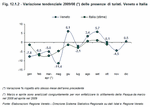 |
| Figure 12.1.3 |
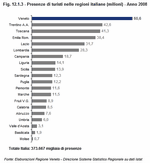 |
| Table 12.1.2 |
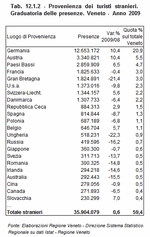 |
| Table 12.1.3 |
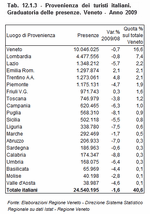 |
| Figure 12.1.4 |
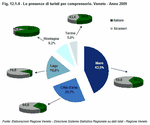 |
| Figure 12.1.5 |
 |
| Figure 12.1.6 |
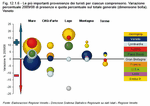 |
| Figure 12.1.7 |
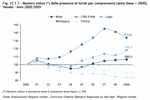 |
| Figure 12.1.8 |
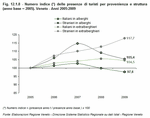 |
| Figure 12.1.9 |
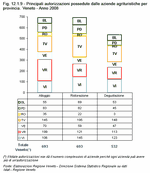 |
| Figure 12.1.10 |
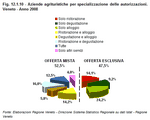 |
| Figure 12.1.11 |
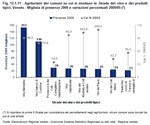 |
| Figure 12.1.12 |
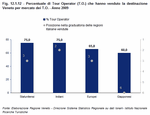 |
| Figure 12.1.13 |
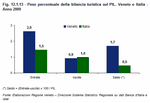 |
| Figure 12.1.14 |
 |
| Figure 12.1.15 |
 |
| Figure 12.1.16 |
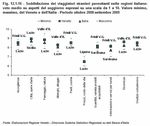 |
|
























